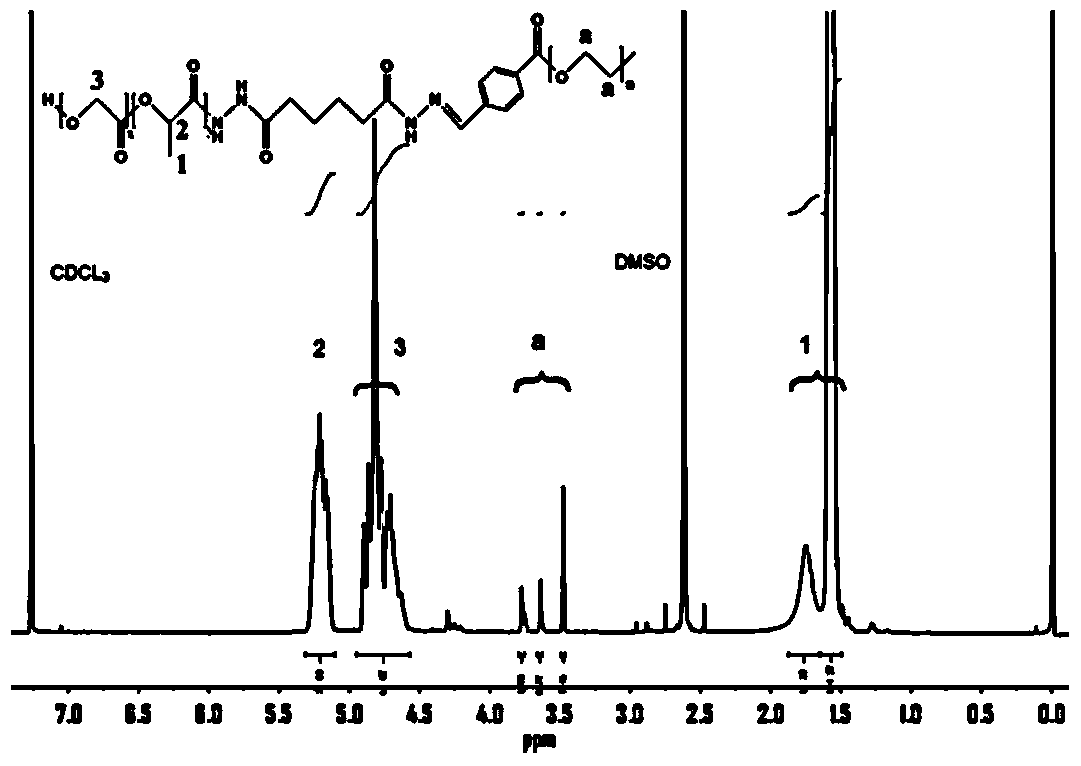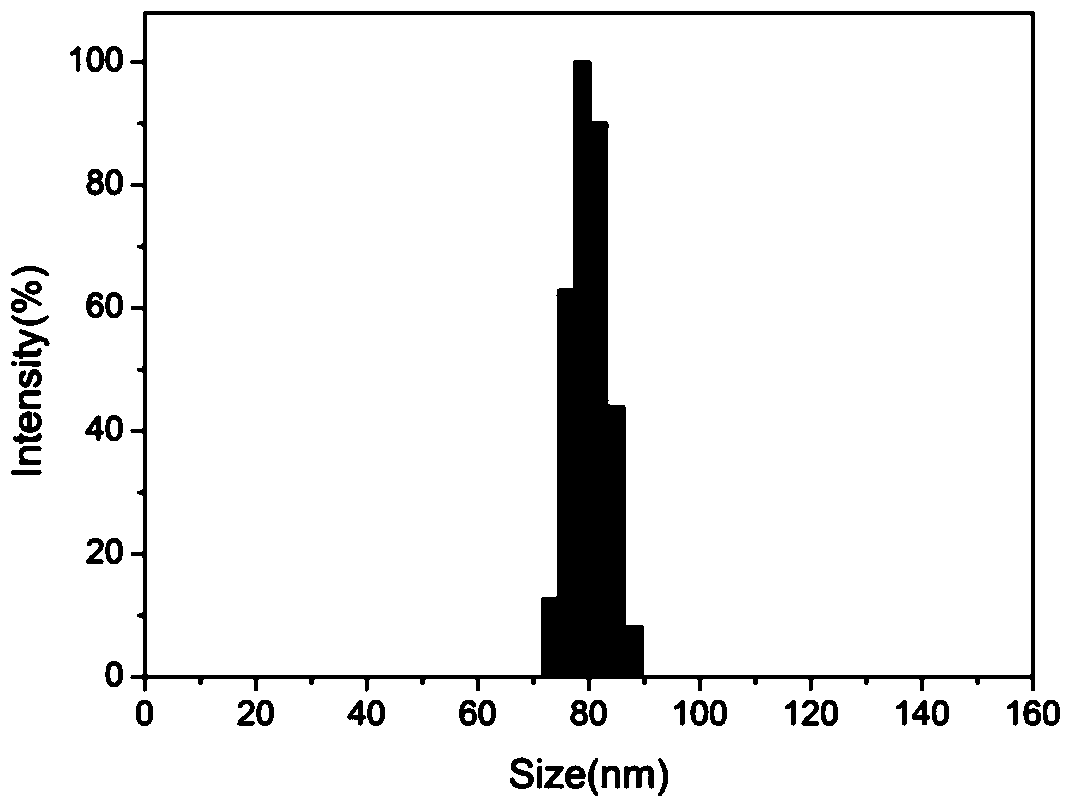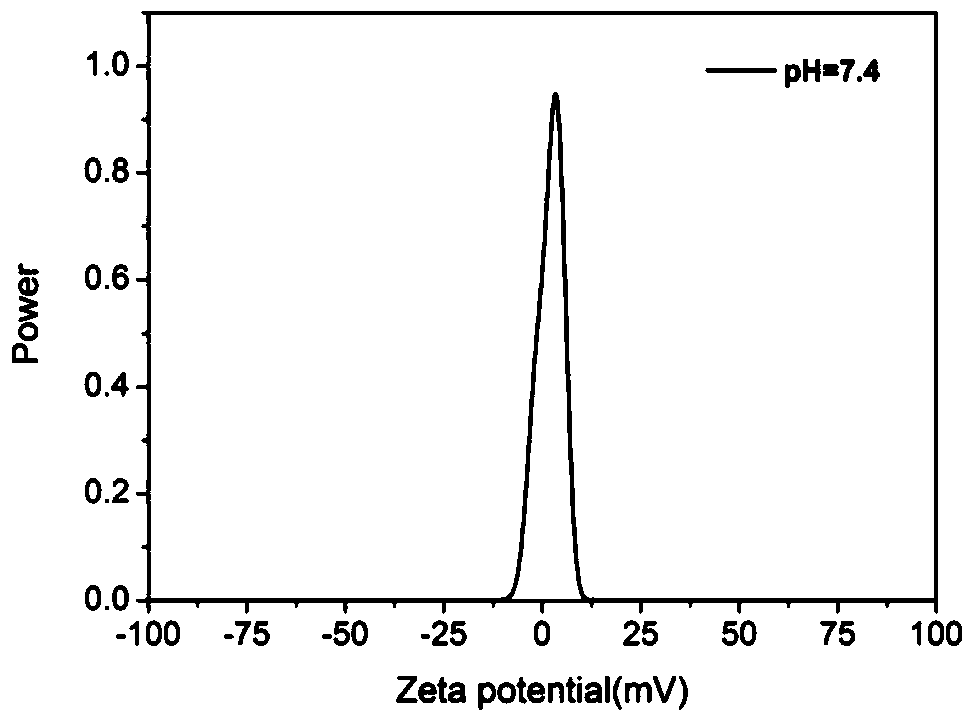A kind of pH-responsive polymer micelles for mucus penetration and preparation method thereof
A technology of polymer micelles and mucus penetration is applied in the field of stimuli-responsive amphiphilic polymer micelles and their preparation, which can solve the problems of hindering the interaction between nanoparticles and cells, reducing the efficiency of nanoparticles entering cells, and reducing drugs. Achieve good mucus permeability, play a carrier role, and increase the effect of cell endocytosis
- Summary
- Abstract
- Description
- Claims
- Application Information
AI Technical Summary
Problems solved by technology
Method used
Image
Examples
preparation example Construction
[0036] A method for preparing a pH-responsive amphiphilic polymer conjugate, the steps are as follows:
[0037] 1) Polylactic acid-glycolic acid copolymer (PLGA), 1-(3-dimethylaminopropyl)-3-ethylcarbodiimide hydrochloride, N-hydroxysuccinimide, adipic acid di The molar ratio of hydrazide is 1:(1.2~5):(1.2~5):(3~10) respectively dissolved in dimethyl sulfoxide, stirred and reacted at room temperature for 24~36 hours, dialyzed in pure water for 24~48 hours and then freeze-dried A hydrazinolated PLGA polymer was obtained.
[0038]2) Polyethylene glycol (PEG), p-aldehyde benzoic acid, 1-(3-dimethylaminopropyl)-3-ethylcarbodiimide hydrochloride, 4-dimethylaminopyridine in molar ratio 1:(1.2~5):(1.2~5):(3~10) were dissolved in N,N-dimethylformamide respectively, stirred and reacted at room temperature for 24~36h, precipitated and filtered with glacial ether, and dried under vacuum to obtain aldehyde Kylated PEG.
[0039] 3) Dissolve hydrazinated PLGA and aldylated PEG in dimethy...
Embodiment 1
[0050] Synthesis of pH-responsive amphiphilic polymer conjugates.
[0051] 1) Depolylactic-co-glycolic acid (PLGA) 1g, 1-(3-dimethylaminopropyl)-3-ethylcarbodiimide hydrochloride 100mg, N-hydroxysuccinimide 60mg, hexyl 75 mg of diacid dihydrazide was dissolved in 10 ml of dimethyl sulfoxide, stirred at room temperature for 24 hours, dialyzed in pure water for 24 hours, and then freeze-dried to obtain a hydrazinolated PLGA polymer.
[0052] 2) Polyethylene glycol (PEG) 2g, p-aldehyde benzoic acid 200mg, 1-(3-dimethylaminopropyl)-3-ethylcarbodiimide hydrochloride 192mg, 4-dimethylaminopyridine 100mg, respectively dissolved in 8ml of N,N-dimethylformamide, stirred at room temperature for 24h, precipitated with glacial ether, filtered, and dried in vacuo to obtain alhydized PEG.
[0053] 3) Dissolve 500mg of hydrazinolated PLGA and 640mg of aldehydelated PEG in 10ml of dimethyl sulfoxide, and reflux at 70°C for 72h under the protection of argon. After the reaction is completed, t...
Embodiment 2
[0056] Synthesis of pH-responsive amphiphilic polymer conjugates.
[0057] 1) Depolylactic-co-glycolic acid (PLGA) 0.4g, 1-(3-dimethylaminopropyl)-3-ethylcarbodiimide hydrochloride 70mg, N-hydroxysuccinimide 45mg, 55 mg of adipic dihydrazide was dissolved in 8 ml of dimethyl sulfoxide, stirred at room temperature for 28 hours, dialyzed in pure water for 26 hours, and then freeze-dried to obtain a hydrazinolated PLGA polymer.
[0058] 2) 0.3g of polyethylene glycol (PEG), 60mg of p-aldehyde benzoic acid, 80mg of 1-(3-dimethylaminopropyl)-3-ethylcarbodiimide hydrochloride, 4-dimethylamino Dissolve 30 mg of pyridine in 6 ml of N,N-dimethylformamide, stir at room temperature for 28 h, precipitate and filter with glacial ether, and dry in vacuo to obtain alhydized PEG.
[0059] 3) Dissolve 420mg of hydrazinolated PLGA and 650mg of aldehydelated PEG in 8ml of dimethyl sulfoxide, and reflux at 75°C for 64h under the protection of argon. After the reaction is completed, the reaction ...
PUM
| Property | Measurement | Unit |
|---|---|---|
| molecular weight | aaaaa | aaaaa |
| molecular weight | aaaaa | aaaaa |
| particle size | aaaaa | aaaaa |
Abstract
Description
Claims
Application Information
 Login to View More
Login to View More - R&D
- Intellectual Property
- Life Sciences
- Materials
- Tech Scout
- Unparalleled Data Quality
- Higher Quality Content
- 60% Fewer Hallucinations
Browse by: Latest US Patents, China's latest patents, Technical Efficacy Thesaurus, Application Domain, Technology Topic, Popular Technical Reports.
© 2025 PatSnap. All rights reserved.Legal|Privacy policy|Modern Slavery Act Transparency Statement|Sitemap|About US| Contact US: help@patsnap.com



